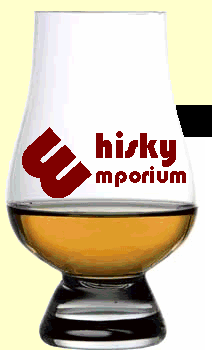|
New to
Whisky?
A little
help with the basics & terminology
| |
 |
|
The world of whisky
and especially Scotch whisky is filled with specialised
terminology which at first glance may, at best, confuse the
newcomer or, at worst, drive them away from what could have been
a wonderful journey of discovery. So, in this feature from
Whisky Emporium I aim to help with an explanation of some of the
termonology surrounding this great gift to the world to which
our master distillers and blenders dedicate their lives. |
|
| |
The
Stills
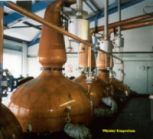 |
|
The spirit which
after a period of maturation will be called whisky is produced
through a process of distillation. But first, we begin with
barley which is soaked in water to allow it to begin the process
of germination, then it is dried, ground (into Grist) and added
to hot water where it is allowed to ferment. This is a process
called Mashing and takes place in a large container called a
Mash Tun. This process creates a liquid rich in fermentable
sugars which will later produce alcohol and is called the Wort.
Yeast is added and the liquid sits for up to 4 days in another
vessel called the Washback, allowing it to fully ferment. At
this stage the liquid is like a strong beer with up to 10% ABV
strength, so in order to increase the alocohol strength it now
needs to be distilled. |
|
| |
Distillation takes
place in stills known as 'Pot Stills' which are in fact, made
from copper. There are two types of still; first the Wash Still
is used, sometimes repeatedly, then the resulting liquid, called
the Low Wines is further distilled in a smaller still called the
Spirit Still in order to finally produce the spirit that will
become whisky. However, not all this liquid has the honour of
being selected to become whisky. The spirit coming out of this
process is divided into three 'cuts', the Head, Heart and Tail.
Only the middle cut (Heart) is considered perfect for whisky,
the heads and tails are not. |
|
| |
Did
you know that the shape of still defines the overall
character of the resulting whisky? Tall narrow still create
lighter, more floral or aromatic whiskies, whereas shorter ones
create heavier, more full-bodied whiskies.
Coffey Stills; In the early 1800's a different type of still
was also being used, these were continuos ones called Coffey
Stills and were more efficient than Pot Stills as they produced
less-flawed spirit. Unfortunately, these 'flaws' included many
desirable flavours and much of the character of malt whisky, so
use of them in malt whisky production was stopped, but they are
still used today in the production of grain whisky. |
|
| |
The
Casks
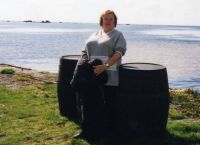
as
modelled by my dear wife |
|
The spirit (Head)
selected for maturation to become whisky is filled into oak
casks where it sits in warehouses for a minimum of three years
before it can be called 'whisky'. Up until that time it is
referred to as New Make or New Spirit. This spirit always used
to be filled into the casks at full strength, straight from the
stills, but today it is often filled at strengths of around
63-65% ABV.
The casks themselves are usually made from either
American White Oak or European Oak as these have proven to be
the best for whisky maturation. Although 'new oak' has been used,
current thought is that previously-used casks help add more
character to the whisky and the ones in widespread use today are
ex-bourbon or ex-sherry casks. |
|
| |
American law dictates that casks
may only be used once for bourbon maturation, so these are a
sensible and very common option for Scotch whisky as they are
dismantled and shipped to Scotland after that single use. Sherry
casks are, obviously, made from European Oak and sourced in the
major sherry-producing regions of Spain. The first time a sherry
cask is used for whisky it is referred to as 'First Fill', then
second-fill ... etc. |
|
| |
Cask sizes &
volumes; Bourbon casks are generally 200 litres in size and
referred to as 'Barrels'. Sherry casks come in various sizes
which include Hogsheads (250 litres), Butts (500 litres) and
sometimes Puncheons (450 litres).
As maturation is dependent
upon time spent in a warehouse and the interaction between the
spirit and the wood, some distilleries have begun to use what
they call Quarter Casks (125 litres) as they increase the
percentage of the whisky in direct contact with the wood, thus
aiding or even speeding up and intensifying maturation, creating
a whisky with totally different character to one from a 500
litre butt over the same period of time. |
|
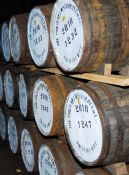 |
|
| |
Did you know
that the colour of a whisky is highly dependent upon the type of
cask used? Bourbon casks will produce much lighter-coloured
whiskies than sherry casks, but some producers also use
artifical colouring (caramel) to help darken their products.
Here in Germany this must be stated on the labels, but this is
not yet the case in all countries.
Flavour is also
dependent upon the types of cask used; As bourbon casks are
charred on the inside, these carbon deposits help filter the
impurities from the spirit during maturation and also help
produce vanilla flavours in the resulting whiskies, whereas
sherry casks help produce richer, dark fruit (like raisin, prune
& currant) flavours in the whisky, along with stronger wood (oak)
and sherry ones. Obviously, first-fill casks produce richer
flavours than second-fill ones ...... and so on. |
|
| |
The
Whisky
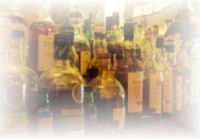 |
|
So, the new spirit must be matured
in oak casks for a
minimum of three years before it may be called whisky. However,
this process called maturation causes some of the spirit to be
'lost' due to the fact that the casks 'breathe'. This loss, or
evaporation, is affectionately known as the "Angel's Share".
The
whisky that remains will have also lost some of the original (ABV)
strength and if filled at 63% it will, after three years, have
dropped to around 55-60%. |
|
| |
The whisky may be
left to mature for more years, or bottled, depending upon many
factors including quality, standard age expressions for that
distillery, economics (the bean-counters always have their say)
and the whims or choices of the Master distillers and blenders.
Below you will find
some more common terminology for whisky. |
|
| |
Original
Distillery Bottling (OB) |
|
| |
Whisky which is
bottled directly for the producing distillery and not sold on to
private individuals or independent bottling companies for them
to bottle is known as an 'OB' or Original Distillery Bottling.
Many distilleries
have set ages for bottling whisky which they believe best
highlight their whisky's characteristics, so they bottle and
sell the whisky at these ages. For example Ardbeg 10y, Laphroaig
10y |
|
| |
Independent
Bottling (IB) |
|
| |
Distilleries also
sell casks to other companies for them to bottle and sell, or
even to private indiviuals or clubs and societies. Once bottled
these offerings are known as IBs or Independent Bottlings. Some
of the more well known Independent Bottlers include Gordon &
MacPhail (G&M), Signatory, Douglas Laing, Murray McDavid and
Hart Brother's just to name a few. |
|
| |
Single Malt
Whisky |
|
| |
Single Malt whisky
basically means the product of just one distillery', so
everything in that particular bottle is the output of just one
distillery, usually named on the label. For example; The
Glenlivet Single Malt means all the whisky in that bottle was
produced by The Glenlivet Distillery. |
|
| |
Single Cask
Whisky |
|
| |
Single Cask whisky
means that not only is it the product of one distillery, but
also from only one specific cask from that distillery. By their
very nature single cask bottlings are limited editions (limited
to the number of bottles from the one cask!) and will often have
the individual cask number and number of bottles detailed on the
label. They may also include the distillation and bottling dates. |
|
| |
Single Grain
Whisky |
|
| |
Whereas Malt whisky
is produced from only malted barley, grain whisky may be
produced from a mix of malted barley, unmalted barley, wheat and
corn. Grain whisky is often very smooth and very little tends to
find its way into bottlings of grain whisky as most of the
production forms the basis of blended whisky. |
|
| |
Blended / Vatted
Whisky |
|
| |
It used to be so
easy; Blended whisky was a mixture or 'blend' of grain and malt
whiskies, whereas vatted whisky was a mixture or 'vatting' of
only malt whiskies. But alas, the SWA has now redefined every
'mix' to be called blended whisky so we have Blended Scotch
whisky, blended grain whisky and blended malt
whisky. |
|
| |
The Age of Whisky |
|
| |
No matter if it's a
single malt, grain, blended, IB or OB, if a whisky label states
an age it refers to the youngest whisky used in that bottling.
So, if the label states 30y, then the bottle may contain whisky
older than 30y, but nothing younger than 30y. |
|
| |
The
Glass
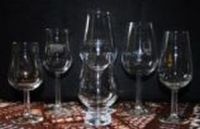 |
|
Other than something to hold our favourite dram, does it matter
which type of glass we use?
You bet it does!
Whisky should be savoured slowly, including the aromas which are
an integral part of the whisky experience and the shape and
style of the glass we use dictates how these aromas are
presented to our noses.
Please click here to view the extemsive
report I recently made on whisky glasses. |
|
| |
The Regions
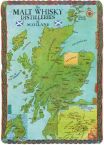 |
|
Scotland tends to be geographically divided into whisky
producing regions. There is often much debate about exactly how
many regions there are and whether a particular whisky belongs
to one or another region, but I personally work with the
following six regions: Lowland, Campbeltown, Highland, Speyside,
Islands & Islay
although I hasten to add that 'Islands' is not an official SWA
recognised region.
It is also
dangerous to make broad statements about all whiskies within a
region as there are always exceptions, but again I usually try
to help beginners by offering the following examples of general
characteristics:
My thanks to Thorleif for permission to
use his whisky map of Scotland which may be further seen here |
|
| |
Lowland |
|
Lowland whiskies are traditionally triple distilled and due to
the tall narrow stills which are typically used by this region’s
distilleries, tend to be light and more aromatic in character.
|
|
| |
Campbeltown |
|
Once a thriving and
possibly a major whisky-producing
region, but sadly few names now remain. |
|
| |
Highland |
|
Very often, but not exclusively, quite rich-tasting and
full-bodied, Highland whiskies offer an insight into the richer,
more powerful flavours of Scottish single malts. |
|
| |
Speyside |
|
Home to many of the household names in Scottish single malts and
also to
about
half
of all Scottish distilleries, Speyside remains the largest
regional producer of single malt whisky. Speyside whiskies
typically offer a variety of flavours and are often described as
‘complex’ due to the wonderful combination
of flavours
one can experience within a single
expression. |
|
| |
Islands |
|
Island whiskies offer a whole range of
styles and flavours thanks to the variety of different
distilleries and geographical locations covered by this region.
|
|
| |
Islay |
|
Although
also
an island, Islay enjoys its own regional categorisation due to
its typical style of whiskies. Thanks to the unique geology of
the island, the resident distilleries produce some of the most
distinctive drams, encompassing the strong flavours of peat,
smoke, sea, salt and iodine. |
|
| |
One
final word from the author; Don't put ice in your whisky, it
kills the flavour and enjoyment!
Slàinte
Mhath
Keith
Wood, Whisky Emporium |
|
© Copyright
2009-2020 by Keith Wood - All rights reserved - Whisky-Emporium |
 |
